Prenatal Development and Childhood Impact
VerifiedAdded on 2020/03/23
|8
|1736
|56
AI Summary
This assignment delves into the critical influence of prenatal factors on a child's development. It examines how elements like maternal stress, diet, and exposure to environmental toxins can shape fetal growth and have lasting effects on cognitive, emotional, and physical well-being in childhood. The provided references offer insights into the neurological, behavioral, and social implications of these prenatal influences.
Contribute Materials
Your contribution can guide someone’s learning journey. Share your
documents today.
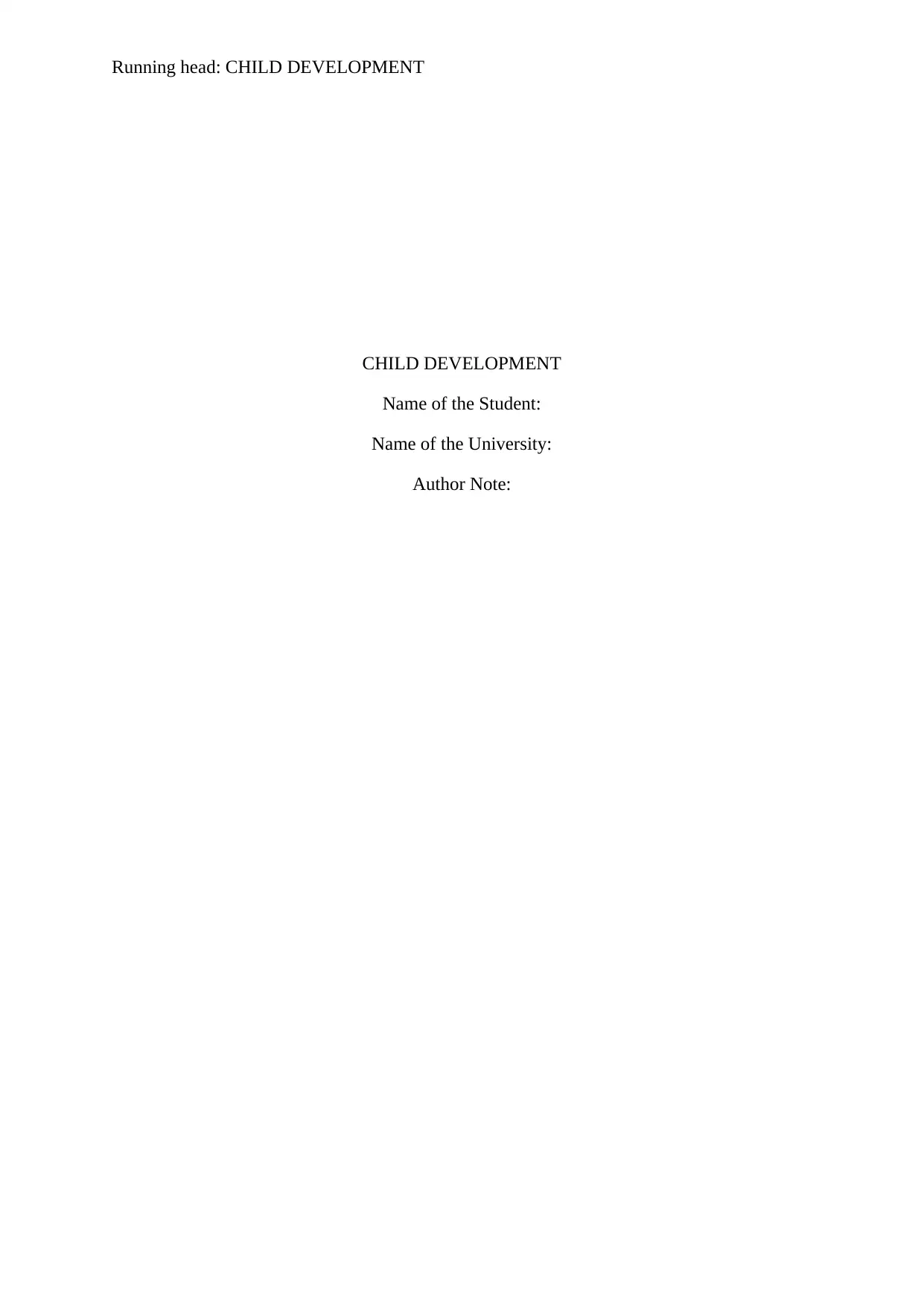
Running head: CHILD DEVELOPMENT
CHILD DEVELOPMENT
Name of the Student:
Name of the University:
Author Note:
CHILD DEVELOPMENT
Name of the Student:
Name of the University:
Author Note:
Secure Best Marks with AI Grader
Need help grading? Try our AI Grader for instant feedback on your assignments.
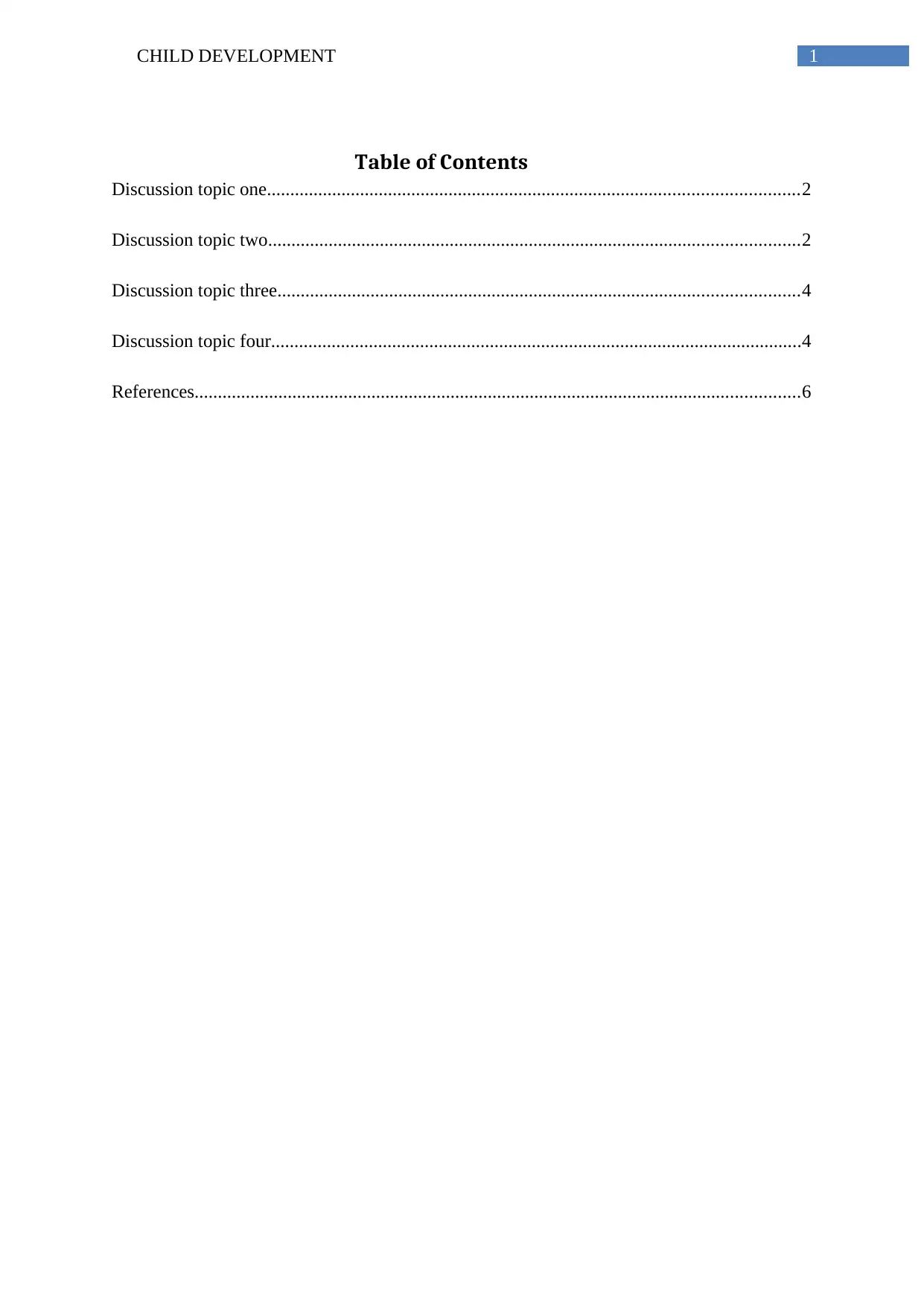
1CHILD DEVELOPMENT
Table of Contents
Discussion topic one..................................................................................................................2
Discussion topic two..................................................................................................................2
Discussion topic three................................................................................................................4
Discussion topic four..................................................................................................................4
References..................................................................................................................................6
Table of Contents
Discussion topic one..................................................................................................................2
Discussion topic two..................................................................................................................2
Discussion topic three................................................................................................................4
Discussion topic four..................................................................................................................4
References..................................................................................................................................6

2CHILD DEVELOPMENT
Discussion topic one
Pregnancy or the gestation period can be described as the developmental period of
one or more offspring in the womb of a woman. There are also many theories that are
associated with the gestation period. Some parts of the world have some weird rituals and
theories regarding the childbirth. The people of china feed the placenta, which is the source
of nutrition for the child (Thompson, Vamos, & Daley, 2017). The hormones of the placenta,
according to modern physicians help the mother to cope up with the post partum depression.
In western countries, the new borns are wrapped to keep them secured and free from
malevolent spirits (Smidt, 2013).
There is Freud’s psychosexual development theory which states that childhood
experiences and unconscious desires influence behaviours. These theories help us to gather
knowledge about the pregnancy and the development of the child (Smith & Blades, 2015).
Erikson’s psychoanalytical theory states that there are eight important stages where the
individual experiences growth and changes throughout the lifespan. His theory also focuses
on social interaction and conflicts that arise in different stages. There is an also behavioural
child development theory which describes how environmental interaction influences
behaviours in children. Moreover, there are also Piaget's Cognitive Developmental Theory
which shows the cognitive development of children through various developmental
milestones sequentially (Bremner, 2017).
Discussion topic two
One of the predominant means that is useful for the assessment of the child is the
developmental milestones. These developmental milestones help to understand how children
learn and grow throughout lives. It helps to identify the delay in the normal cognitive
Discussion topic one
Pregnancy or the gestation period can be described as the developmental period of
one or more offspring in the womb of a woman. There are also many theories that are
associated with the gestation period. Some parts of the world have some weird rituals and
theories regarding the childbirth. The people of china feed the placenta, which is the source
of nutrition for the child (Thompson, Vamos, & Daley, 2017). The hormones of the placenta,
according to modern physicians help the mother to cope up with the post partum depression.
In western countries, the new borns are wrapped to keep them secured and free from
malevolent spirits (Smidt, 2013).
There is Freud’s psychosexual development theory which states that childhood
experiences and unconscious desires influence behaviours. These theories help us to gather
knowledge about the pregnancy and the development of the child (Smith & Blades, 2015).
Erikson’s psychoanalytical theory states that there are eight important stages where the
individual experiences growth and changes throughout the lifespan. His theory also focuses
on social interaction and conflicts that arise in different stages. There is an also behavioural
child development theory which describes how environmental interaction influences
behaviours in children. Moreover, there are also Piaget's Cognitive Developmental Theory
which shows the cognitive development of children through various developmental
milestones sequentially (Bremner, 2017).
Discussion topic two
One of the predominant means that is useful for the assessment of the child is the
developmental milestones. These developmental milestones help to understand how children
learn and grow throughout lives. It helps to identify the delay in the normal cognitive
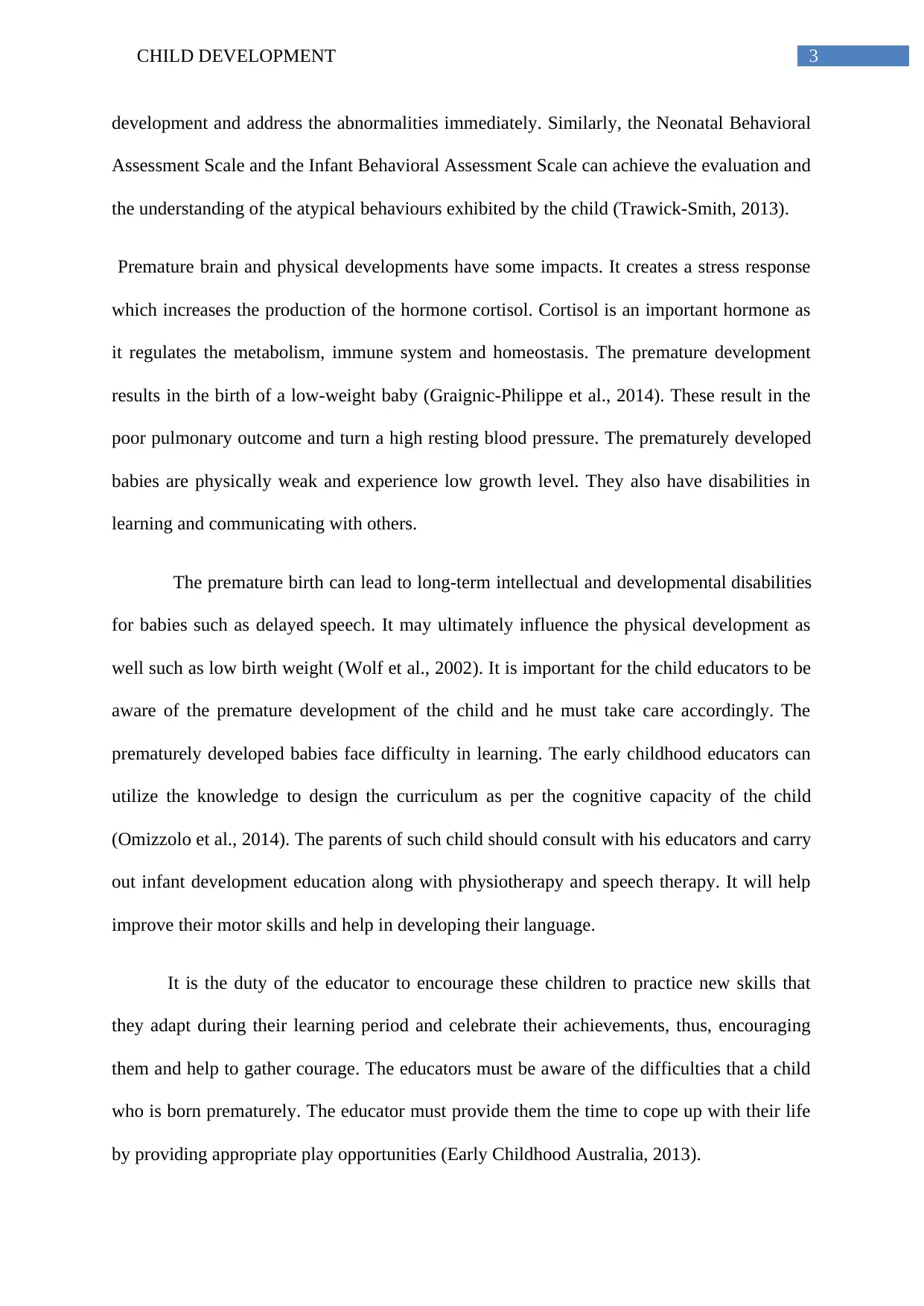
3CHILD DEVELOPMENT
development and address the abnormalities immediately. Similarly, the Neonatal Behavioral
Assessment Scale and the Infant Behavioral Assessment Scale can achieve the evaluation and
the understanding of the atypical behaviours exhibited by the child (Trawick-Smith, 2013).
Premature brain and physical developments have some impacts. It creates a stress response
which increases the production of the hormone cortisol. Cortisol is an important hormone as
it regulates the metabolism, immune system and homeostasis. The premature development
results in the birth of a low-weight baby (Graignic-Philippe et al., 2014). These result in the
poor pulmonary outcome and turn a high resting blood pressure. The prematurely developed
babies are physically weak and experience low growth level. They also have disabilities in
learning and communicating with others.
The premature birth can lead to long-term intellectual and developmental disabilities
for babies such as delayed speech. It may ultimately influence the physical development as
well such as low birth weight (Wolf et al., 2002). It is important for the child educators to be
aware of the premature development of the child and he must take care accordingly. The
prematurely developed babies face difficulty in learning. The early childhood educators can
utilize the knowledge to design the curriculum as per the cognitive capacity of the child
(Omizzolo et al., 2014). The parents of such child should consult with his educators and carry
out infant development education along with physiotherapy and speech therapy. It will help
improve their motor skills and help in developing their language.
It is the duty of the educator to encourage these children to practice new skills that
they adapt during their learning period and celebrate their achievements, thus, encouraging
them and help to gather courage. The educators must be aware of the difficulties that a child
who is born prematurely. The educator must provide them the time to cope up with their life
by providing appropriate play opportunities (Early Childhood Australia, 2013).
development and address the abnormalities immediately. Similarly, the Neonatal Behavioral
Assessment Scale and the Infant Behavioral Assessment Scale can achieve the evaluation and
the understanding of the atypical behaviours exhibited by the child (Trawick-Smith, 2013).
Premature brain and physical developments have some impacts. It creates a stress response
which increases the production of the hormone cortisol. Cortisol is an important hormone as
it regulates the metabolism, immune system and homeostasis. The premature development
results in the birth of a low-weight baby (Graignic-Philippe et al., 2014). These result in the
poor pulmonary outcome and turn a high resting blood pressure. The prematurely developed
babies are physically weak and experience low growth level. They also have disabilities in
learning and communicating with others.
The premature birth can lead to long-term intellectual and developmental disabilities
for babies such as delayed speech. It may ultimately influence the physical development as
well such as low birth weight (Wolf et al., 2002). It is important for the child educators to be
aware of the premature development of the child and he must take care accordingly. The
prematurely developed babies face difficulty in learning. The early childhood educators can
utilize the knowledge to design the curriculum as per the cognitive capacity of the child
(Omizzolo et al., 2014). The parents of such child should consult with his educators and carry
out infant development education along with physiotherapy and speech therapy. It will help
improve their motor skills and help in developing their language.
It is the duty of the educator to encourage these children to practice new skills that
they adapt during their learning period and celebrate their achievements, thus, encouraging
them and help to gather courage. The educators must be aware of the difficulties that a child
who is born prematurely. The educator must provide them the time to cope up with their life
by providing appropriate play opportunities (Early Childhood Australia, 2013).
Secure Best Marks with AI Grader
Need help grading? Try our AI Grader for instant feedback on your assignments.
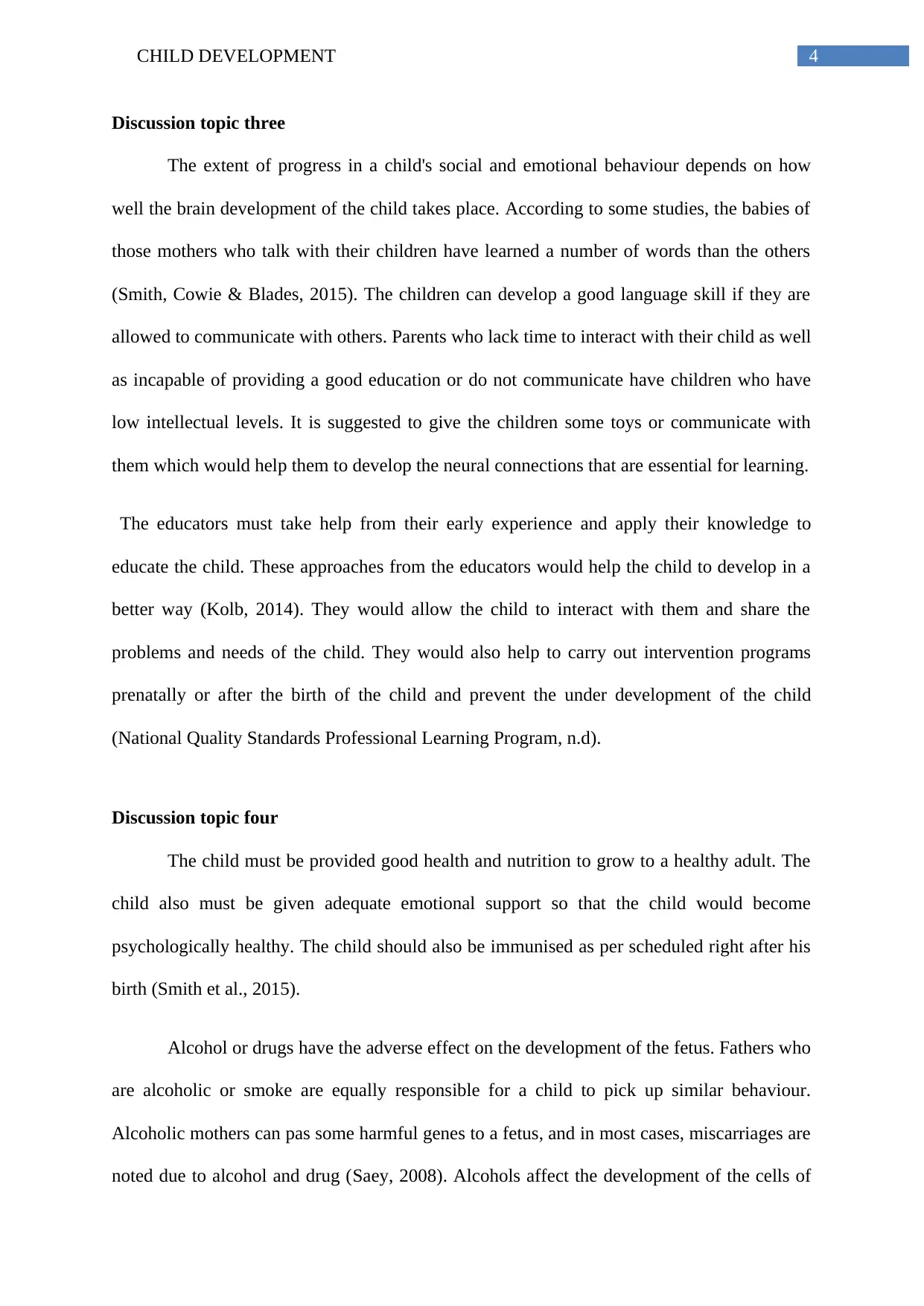
4CHILD DEVELOPMENT
Discussion topic three
The extent of progress in a child's social and emotional behaviour depends on how
well the brain development of the child takes place. According to some studies, the babies of
those mothers who talk with their children have learned a number of words than the others
(Smith, Cowie & Blades, 2015). The children can develop a good language skill if they are
allowed to communicate with others. Parents who lack time to interact with their child as well
as incapable of providing a good education or do not communicate have children who have
low intellectual levels. It is suggested to give the children some toys or communicate with
them which would help them to develop the neural connections that are essential for learning.
The educators must take help from their early experience and apply their knowledge to
educate the child. These approaches from the educators would help the child to develop in a
better way (Kolb, 2014). They would allow the child to interact with them and share the
problems and needs of the child. They would also help to carry out intervention programs
prenatally or after the birth of the child and prevent the under development of the child
(National Quality Standards Professional Learning Program, n.d).
Discussion topic four
The child must be provided good health and nutrition to grow to a healthy adult. The
child also must be given adequate emotional support so that the child would become
psychologically healthy. The child should also be immunised as per scheduled right after his
birth (Smith et al., 2015).
Alcohol or drugs have the adverse effect on the development of the fetus. Fathers who
are alcoholic or smoke are equally responsible for a child to pick up similar behaviour.
Alcoholic mothers can pas some harmful genes to a fetus, and in most cases, miscarriages are
noted due to alcohol and drug (Saey, 2008). Alcohols affect the development of the cells of
Discussion topic three
The extent of progress in a child's social and emotional behaviour depends on how
well the brain development of the child takes place. According to some studies, the babies of
those mothers who talk with their children have learned a number of words than the others
(Smith, Cowie & Blades, 2015). The children can develop a good language skill if they are
allowed to communicate with others. Parents who lack time to interact with their child as well
as incapable of providing a good education or do not communicate have children who have
low intellectual levels. It is suggested to give the children some toys or communicate with
them which would help them to develop the neural connections that are essential for learning.
The educators must take help from their early experience and apply their knowledge to
educate the child. These approaches from the educators would help the child to develop in a
better way (Kolb, 2014). They would allow the child to interact with them and share the
problems and needs of the child. They would also help to carry out intervention programs
prenatally or after the birth of the child and prevent the under development of the child
(National Quality Standards Professional Learning Program, n.d).
Discussion topic four
The child must be provided good health and nutrition to grow to a healthy adult. The
child also must be given adequate emotional support so that the child would become
psychologically healthy. The child should also be immunised as per scheduled right after his
birth (Smith et al., 2015).
Alcohol or drugs have the adverse effect on the development of the fetus. Fathers who
are alcoholic or smoke are equally responsible for a child to pick up similar behaviour.
Alcoholic mothers can pas some harmful genes to a fetus, and in most cases, miscarriages are
noted due to alcohol and drug (Saey, 2008). Alcohols affect the development of the cells of
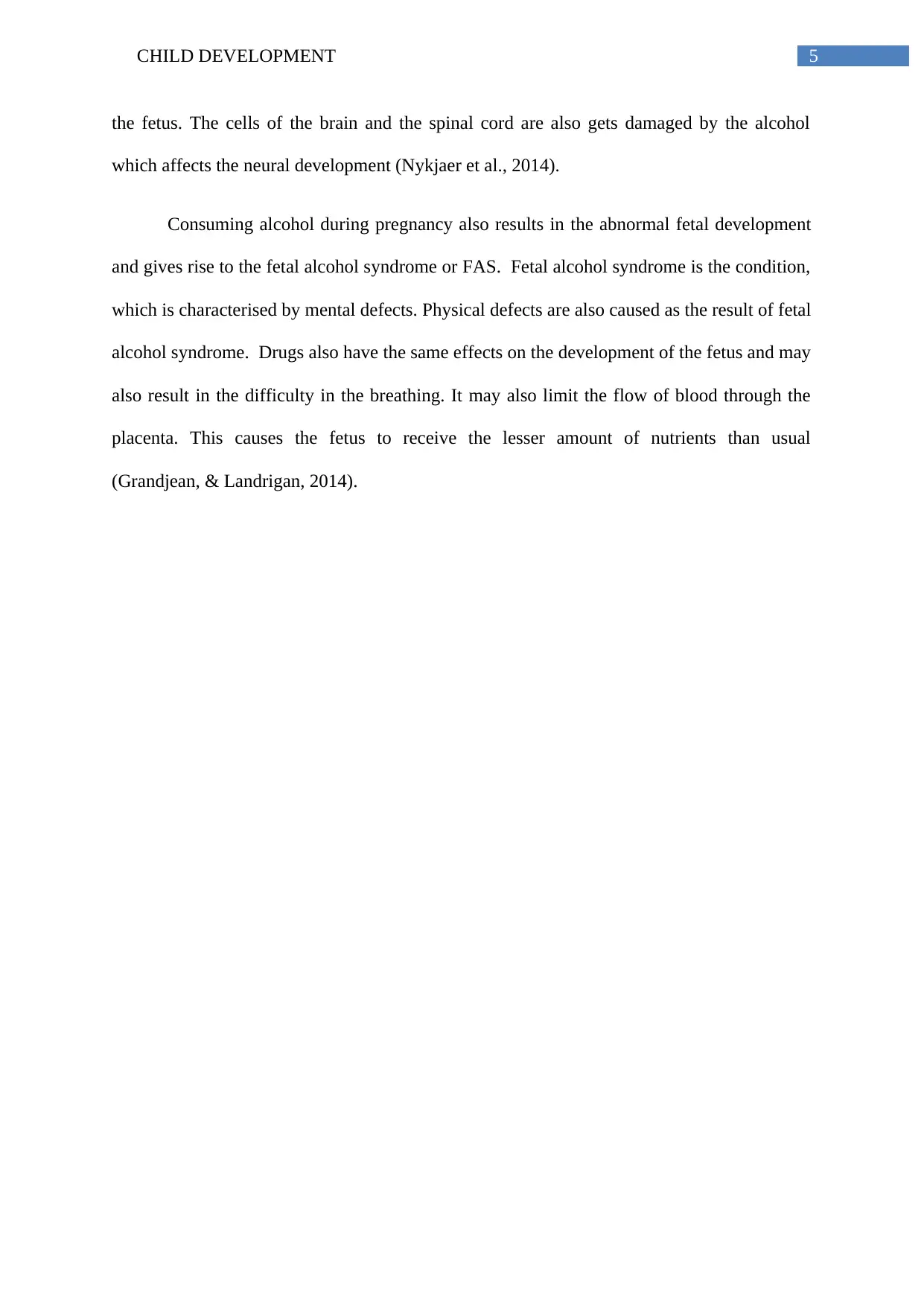
5CHILD DEVELOPMENT
the fetus. The cells of the brain and the spinal cord are also gets damaged by the alcohol
which affects the neural development (Nykjaer et al., 2014).
Consuming alcohol during pregnancy also results in the abnormal fetal development
and gives rise to the fetal alcohol syndrome or FAS. Fetal alcohol syndrome is the condition,
which is characterised by mental defects. Physical defects are also caused as the result of fetal
alcohol syndrome. Drugs also have the same effects on the development of the fetus and may
also result in the difficulty in the breathing. It may also limit the flow of blood through the
placenta. This causes the fetus to receive the lesser amount of nutrients than usual
(Grandjean, & Landrigan, 2014).
the fetus. The cells of the brain and the spinal cord are also gets damaged by the alcohol
which affects the neural development (Nykjaer et al., 2014).
Consuming alcohol during pregnancy also results in the abnormal fetal development
and gives rise to the fetal alcohol syndrome or FAS. Fetal alcohol syndrome is the condition,
which is characterised by mental defects. Physical defects are also caused as the result of fetal
alcohol syndrome. Drugs also have the same effects on the development of the fetus and may
also result in the difficulty in the breathing. It may also limit the flow of blood through the
placenta. This causes the fetus to receive the lesser amount of nutrients than usual
(Grandjean, & Landrigan, 2014).
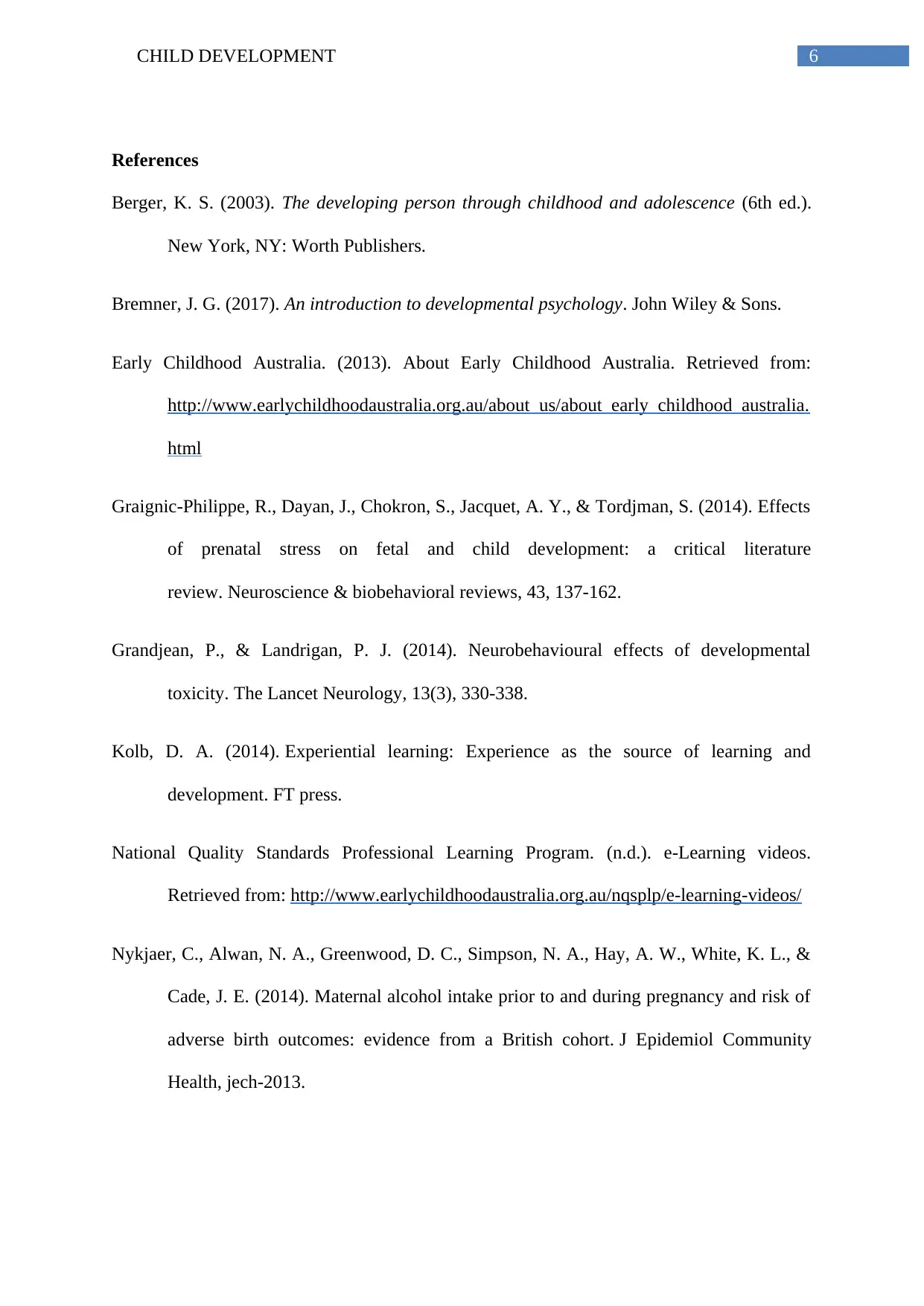
6CHILD DEVELOPMENT
References
Berger, K. S. (2003). The developing person through childhood and adolescence (6th ed.).
New York, NY: Worth Publishers.
Bremner, J. G. (2017). An introduction to developmental psychology. John Wiley & Sons.
Early Childhood Australia. (2013). About Early Childhood Australia. Retrieved from:
http://www.earlychildhoodaustralia.org.au/about_us/about_early_childhood_australia.
html
Graignic-Philippe, R., Dayan, J., Chokron, S., Jacquet, A. Y., & Tordjman, S. (2014). Effects
of prenatal stress on fetal and child development: a critical literature
review. Neuroscience & biobehavioral reviews, 43, 137-162.
Grandjean, P., & Landrigan, P. J. (2014). Neurobehavioural effects of developmental
toxicity. The Lancet Neurology, 13(3), 330-338.
Kolb, D. A. (2014). Experiential learning: Experience as the source of learning and
development. FT press.
National Quality Standards Professional Learning Program. (n.d.). e-Learning videos.
Retrieved from: http://www.earlychildhoodaustralia.org.au/nqsplp/e-learning-videos/
Nykjaer, C., Alwan, N. A., Greenwood, D. C., Simpson, N. A., Hay, A. W., White, K. L., &
Cade, J. E. (2014). Maternal alcohol intake prior to and during pregnancy and risk of
adverse birth outcomes: evidence from a British cohort. J Epidemiol Community
Health, jech-2013.
References
Berger, K. S. (2003). The developing person through childhood and adolescence (6th ed.).
New York, NY: Worth Publishers.
Bremner, J. G. (2017). An introduction to developmental psychology. John Wiley & Sons.
Early Childhood Australia. (2013). About Early Childhood Australia. Retrieved from:
http://www.earlychildhoodaustralia.org.au/about_us/about_early_childhood_australia.
html
Graignic-Philippe, R., Dayan, J., Chokron, S., Jacquet, A. Y., & Tordjman, S. (2014). Effects
of prenatal stress on fetal and child development: a critical literature
review. Neuroscience & biobehavioral reviews, 43, 137-162.
Grandjean, P., & Landrigan, P. J. (2014). Neurobehavioural effects of developmental
toxicity. The Lancet Neurology, 13(3), 330-338.
Kolb, D. A. (2014). Experiential learning: Experience as the source of learning and
development. FT press.
National Quality Standards Professional Learning Program. (n.d.). e-Learning videos.
Retrieved from: http://www.earlychildhoodaustralia.org.au/nqsplp/e-learning-videos/
Nykjaer, C., Alwan, N. A., Greenwood, D. C., Simpson, N. A., Hay, A. W., White, K. L., &
Cade, J. E. (2014). Maternal alcohol intake prior to and during pregnancy and risk of
adverse birth outcomes: evidence from a British cohort. J Epidemiol Community
Health, jech-2013.
Paraphrase This Document
Need a fresh take? Get an instant paraphrase of this document with our AI Paraphraser
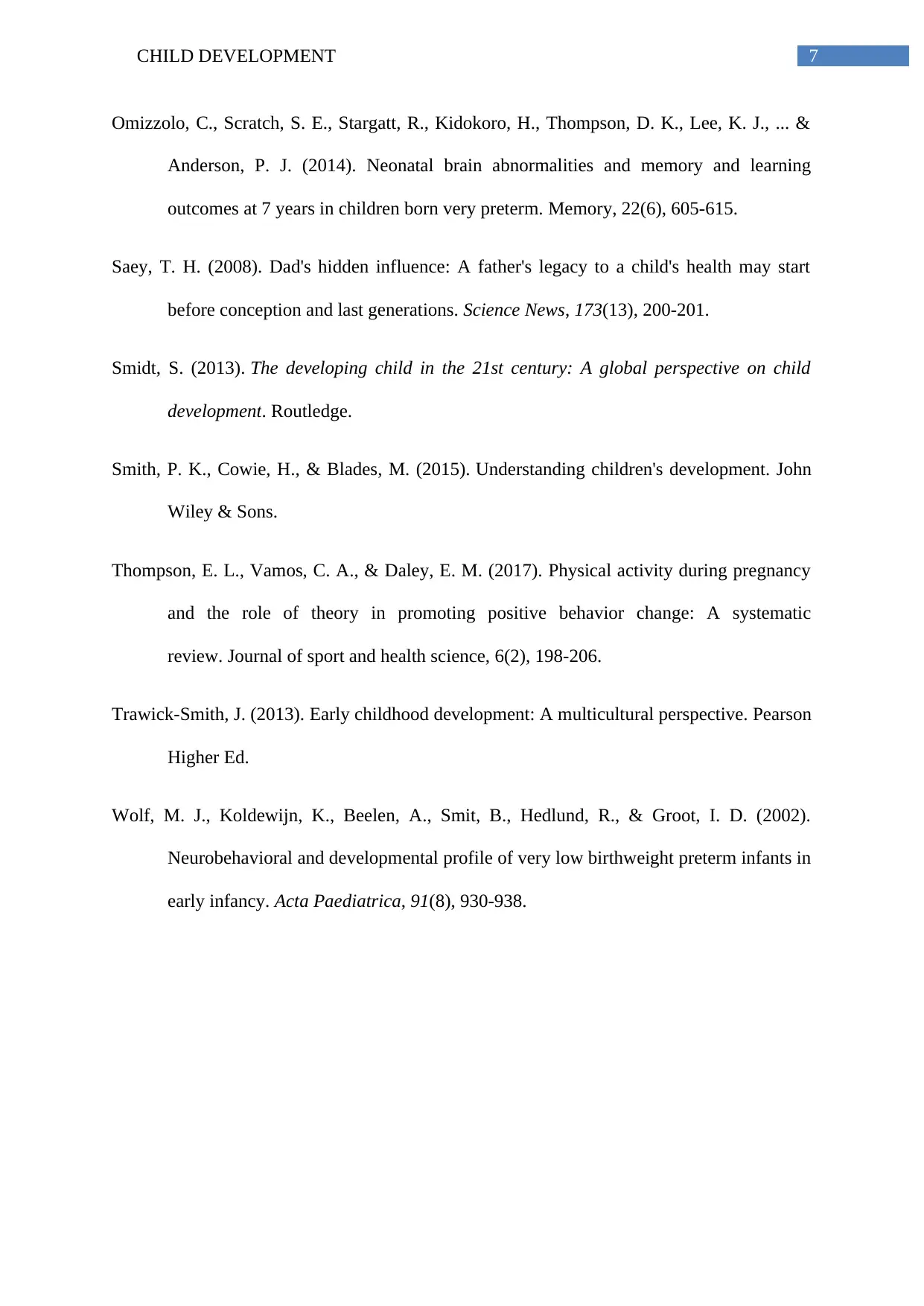
7CHILD DEVELOPMENT
Omizzolo, C., Scratch, S. E., Stargatt, R., Kidokoro, H., Thompson, D. K., Lee, K. J., ... &
Anderson, P. J. (2014). Neonatal brain abnormalities and memory and learning
outcomes at 7 years in children born very preterm. Memory, 22(6), 605-615.
Saey, T. H. (2008). Dad's hidden influence: A father's legacy to a child's health may start
before conception and last generations. Science News, 173(13), 200-201.
Smidt, S. (2013). The developing child in the 21st century: A global perspective on child
development. Routledge.
Smith, P. K., Cowie, H., & Blades, M. (2015). Understanding children's development. John
Wiley & Sons.
Thompson, E. L., Vamos, C. A., & Daley, E. M. (2017). Physical activity during pregnancy
and the role of theory in promoting positive behavior change: A systematic
review. Journal of sport and health science, 6(2), 198-206.
Trawick-Smith, J. (2013). Early childhood development: A multicultural perspective. Pearson
Higher Ed.
Wolf, M. J., Koldewijn, K., Beelen, A., Smit, B., Hedlund, R., & Groot, I. D. (2002).
Neurobehavioral and developmental profile of very low birthweight preterm infants in
early infancy. Acta Paediatrica, 91(8), 930-938.
Omizzolo, C., Scratch, S. E., Stargatt, R., Kidokoro, H., Thompson, D. K., Lee, K. J., ... &
Anderson, P. J. (2014). Neonatal brain abnormalities and memory and learning
outcomes at 7 years in children born very preterm. Memory, 22(6), 605-615.
Saey, T. H. (2008). Dad's hidden influence: A father's legacy to a child's health may start
before conception and last generations. Science News, 173(13), 200-201.
Smidt, S. (2013). The developing child in the 21st century: A global perspective on child
development. Routledge.
Smith, P. K., Cowie, H., & Blades, M. (2015). Understanding children's development. John
Wiley & Sons.
Thompson, E. L., Vamos, C. A., & Daley, E. M. (2017). Physical activity during pregnancy
and the role of theory in promoting positive behavior change: A systematic
review. Journal of sport and health science, 6(2), 198-206.
Trawick-Smith, J. (2013). Early childhood development: A multicultural perspective. Pearson
Higher Ed.
Wolf, M. J., Koldewijn, K., Beelen, A., Smit, B., Hedlund, R., & Groot, I. D. (2002).
Neurobehavioral and developmental profile of very low birthweight preterm infants in
early infancy. Acta Paediatrica, 91(8), 930-938.
1 out of 8
Related Documents
Your All-in-One AI-Powered Toolkit for Academic Success.
+13062052269
info@desklib.com
Available 24*7 on WhatsApp / Email
![[object Object]](/_next/static/media/star-bottom.7253800d.svg)
Unlock your academic potential
© 2024 | Zucol Services PVT LTD | All rights reserved.





